
William Maldon Woodfull was an Australian cricketer of the 1920s and 1930s. He captained both Victoria and Australia, and was best known for his dignified and moral conduct during the tumultuous bodyline series in 1932–33. Trained as a schoolteacher, Woodfull was known for his benevolent attitude towards his players, and his patience and defensive technique as an opening batsman. Woodfull was not a flamboyant player, but was known for his calm, unruffled style and his reliability in difficult situations. His opening pairing with fellow Victorian Bill Ponsford for both his state and Australia remains one of the most successful in history. While not known for his tactical skills, Woodfull was widely admired by his players and observers for his sportsmanship and ability to mould a successful and loyal team through the strength of his character.

Warwick Windridge Armstrong was an Australian cricketer who played 50 Test matches between 1902 and 1921. An all-rounder, he captained Australia in ten Test matches between 1920 and 1921, and was undefeated, winning eight Tests and drawing two. Armstrong was captain of the 1920–21 Australian team which defeated the touring English 5–0: one of only three teams to win an Ashes series in a whitewash. In a Test career interrupted by the First World War, he scored 2,863 runs at an average of 38.68, including six centuries, and took 87 wickets. He was inducted into the Australian Cricket Hall of Fame in 2000.
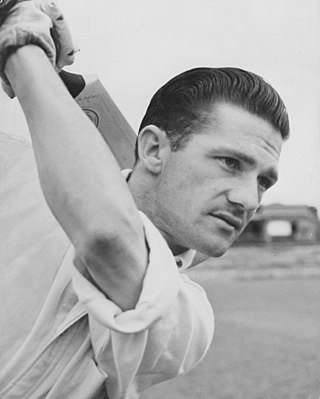
Robert Neil Harvey is an Australian former cricketer who was a member of the Australian cricket team between 1948 and 1963, playing in 79 Test matches. He was the vice-captain of the team from 1957 until his retirement. An attacking left-handed batsman, sharp fielder and occasional off-spin bowler, Harvey was the senior batsman in the Australian team for much of the 1950s and was regarded by Wisden as the finest fielder of his era. Upon his retirement, Harvey was the second-most prolific Test run-scorer and century-maker for Australia.

Clement "Clem" Hill was an Australian cricketer who played 49 Test matches as a specialist batsman between 1896 and 1912. He captained the Australian team in ten Tests, winning five and losing five. A prolific run scorer, Hill scored 3,412 runs in Test cricket—a world record at the time of his retirement—at an average of 39.21 per innings, including seven centuries. In 1902, Hill was the first batsman to make 1,000 Test runs in a calendar year, a feat that would not be repeated for 45 years. His innings of 365 scored against New South Wales for South Australia in 1900–01 was a Sheffield Shield record for 27 years. The South Australian Cricket Association named a grandstand at the Adelaide Oval in his honour in 2003 and he was inducted into the Australian Cricket Hall of Fame in 2005.Hill is regarded as one of the best batsman of his era.
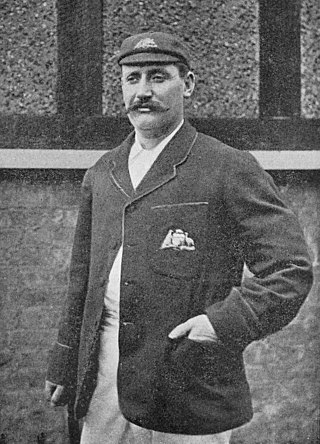
George Henry Stevens Trott was an Australian cricketer who played 24 Test matches as an all-rounder between 1888 and 1898. Although Trott was a versatile batsman, spin bowler and outstanding fielder, "it is as a captain that he is best remembered, an understanding judge of human nature". After a period of some instability and ill discipline in Australian cricket, he was the first in a succession of assertive Australian captains that included Joe Darling, Monty Noble and Clem Hill, who restored the prestige of the Test team. Respected by teammates and opponents alike for his cricketing judgement, Trott was quick to pick up a weakness in opponents. A right-handed batsman, he was known for his sound defence and vigorous hitting. His slow leg-spin bowling was often able to deceive batsmen through subtle variations of pace and flight, but allowed opposition batsmen to score quickly.

Thomas Patrick Horan was an Australian cricketer who played for Victoria and Australia, and later became an esteemed cricket journalist under the pen name "Felix". The first of only two players born in Ireland to play Test cricket for Australia, Horan was the leading batsman in the colony of Victoria during the pioneering years of international cricket. He played for Australia in the game against England subsequently designated as the first Test match, before touring England with the first representative Australian team, in 1878. Four years later, he toured England for the second time and played in the famed Ashes Test match at The Oval.
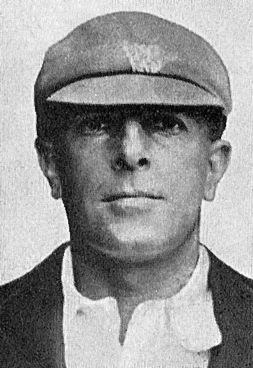
Charles George Macartney was an Australian cricketer who played in 35 Test matches between 1907 and 1926. He was known as "The Governor-General" in reference to his authoritative batting style and his flamboyant strokeplay, which drew comparisons with his close friend and role model Victor Trumper, regarded as one of the most elegant batsmen in cricketing history. Sir Donald Bradman—generally regarded as the greatest batsman in history—cited Macartney's dynamic batting as an inspiration in his cricket career.
Gideon Clifford Jeffrey Davidson Haigh is a British-born Australian journalist and non-fiction author who writes about sport, business and crime in Australia. He was born in London, was raised in Geelong, and lives in Melbourne.

Frank Jonas Laver was an Australian cricketer and baseball player. He played in 15 Test matches between 1899 and 1909 and visited England as a player and team manager on four occasions. An accomplished photographer and author, he wrote an illustrated account of his 1899 and 1905 tours of England, An Australian Cricketer on Tour.
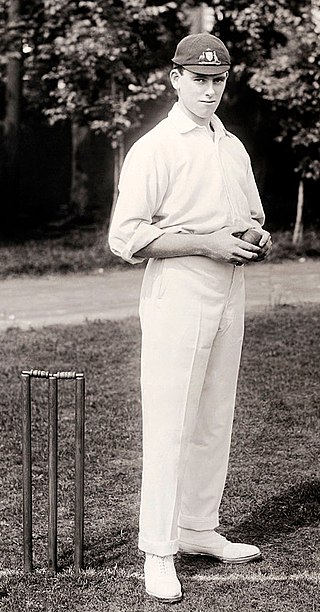
William James Whitty was an Australian cricketer who played 14 Test matches between 1909 and 1912.
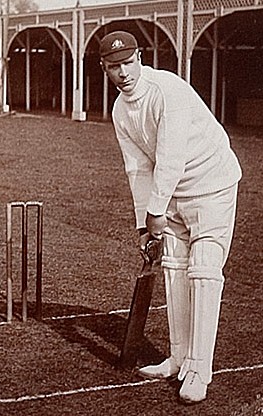
Peter Alexander McAlister was an Australian cricketer who played in eight Test matches from 1904 to 1909.

Albert "Tibby" Cotter was an Australian cricketer who played in 21 Test matches between 1904 and 1912. He served in World War I with the First Australian Imperial Force and was killed in action in the mounted charge of the 4th Light Horse Brigade at Beersheba in Ottoman Palestine.

Cricket is the most popular summer sport in Australia at international, domestic and local levels. It is regarded as the national summer sport, and widely played across the country, especially from the months of September to April. The peak administrative body for both professional and amateur cricket is Cricket Australia. The 2017–18 National Cricket Census showed 1,558,821 Australians engaged in cricket competitions or programs – an increase of 9% from the previous year. 30% of cricket's participants are now female, and 6 in every 10 new participants are female, one of the highest year-on-year participation growth figures. In terms of attendance figures, more than 2.3 million people attended the cricket during the 2017–18 summer, surpassing the record of 1.8 million set in 2016–17.
This article describes the history of Australian cricket from the 1900–01 season until 1918.
Keith Ormond Edley Johnson, was an Australian cricket administrator. He was the manager of the Australian Services cricket team in England, India and Australia immediately after World War II, and of the Australian team that toured England in 1948. The 1948 Australian cricket team earned the sobriquet The Invincibles by being the first side to complete a tour of England without losing a single match.
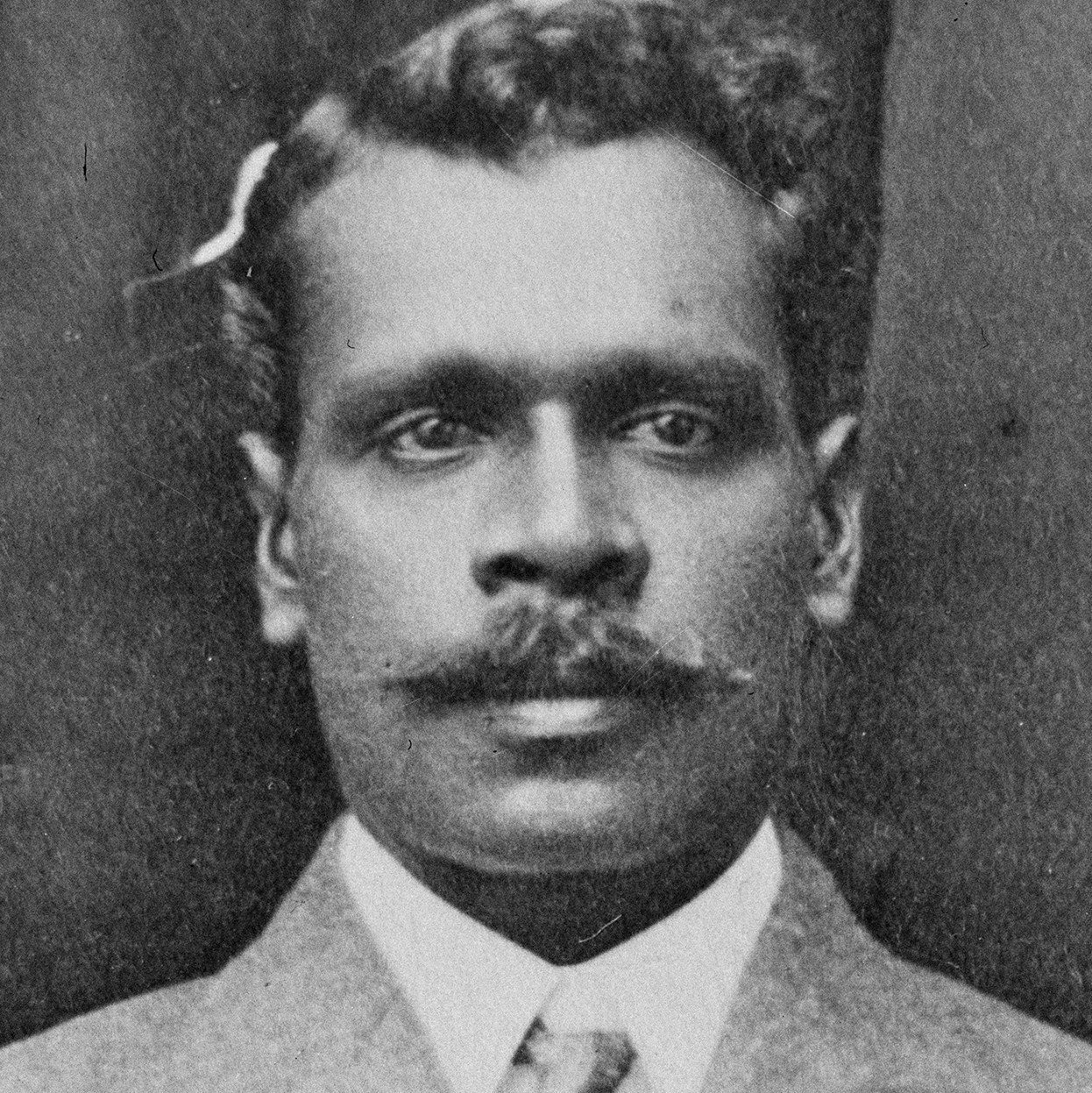
Jack Marsh was an Australian first-class cricketer of Australian Aboriginal descent who represented New South Wales in six matches from 1900–01 to 1902–03. A right-arm fast bowler of extreme pace, Marsh had high athletic qualities and was regarded as one of the outstanding talents of his era. His career was curtailed by continual controversy surrounding the legality of his bowling action; he was no-balled multiple times for throwing. As a result of the debate over the legitimacy of his action, Marsh never established himself at first-class level and was overlooked for national selection. In contemporary discourse, Marsh's lack of opportunities has often been attributed to racial discrimination.
The "Golden Age" of cricket is a nostalgic term that has often been applied in cricket literature to the period in English cricket from 1890, the opening season of the official County Championship, to the outbreak of World War I which occurred just before the scheduled end of the 1914 season. The term has also gained currency in Australian cricket of the same period and in America in reference to the Philadelphian cricket team.

The History of Australian cricket begins over 210 years ago. The first recorded cricket match in Australia took place in Sydney in December 1803 and a report in the Sydney Gazette on 8 January 1804 suggested that cricket was already well established in the infant colony. By 1826, clubs including the Currency Cricket Club, the Military Cricket Club and the Australian Cricket Club had been formed. Hyde Park and the Racecourse were the venue for these organised matches. The formation of clubs in Van Diemen's Land was not far behind with clubs formed in Hobart in 1832 and Launceston (1841). In Western Australia a match was arranged in 1835 between the "builders" of the new Government House and a team of labourers and "mechanics". In Victoria in 1838, the Melbourne Cricket Club was formed – it would become arguably Australia's most exclusive and influential cricket club. In 1839, a club was formed in South Australia.

Victor Thomas Trumper was an Australian cricketer known as the most stylish and versatile batsman of the Golden Age of cricket, capable of playing match-winning innings on wet wickets his contemporaries found unplayable. Archie MacLaren said of him, "Compared to Victor I was a cab-horse to a Derby winner". Trumper was also a key figure in the foundation of rugby league in Australia. His photograph taken by George Beldam in 1905 is often considered to be the greatest cricketing photograph ever taken.
The Australia national cricket team toured New Zealand from February to April 1910 and played seven first-class matches including two against the New Zealand national cricket team. New Zealand at this time had not been elevated to Test status.















